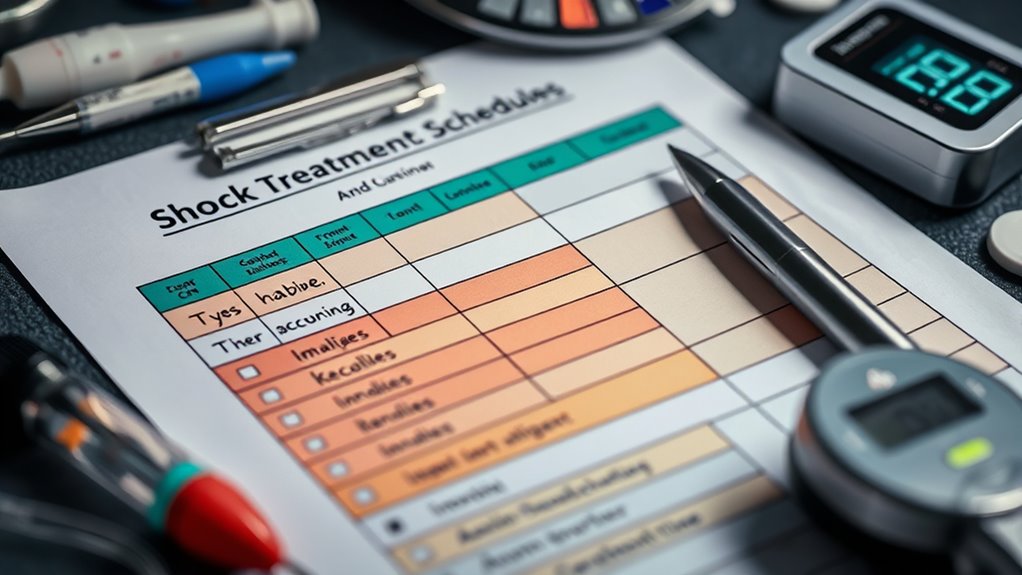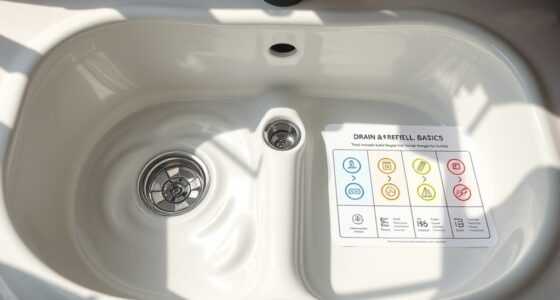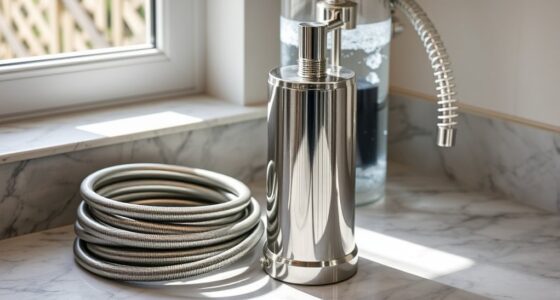To keep your pool or spa crystal clear, create a shock treatment schedule based on usage, weather, and water conditions. Test regular water parameters like pH, alkalinity, and stabilizer before applying any shock. Adjust the frequency accordingly—more often during hot, sunny days or after storms. Proper timing prevents imbalances and extends equipment life. Stay organized and consistent to maintain ideal water quality—continue exploring to master the best practices for effective shock treatments.
Key Takeaways
- Regularly test water chemistry to determine optimal shock timing and dosage.
- Schedule shocks after heavy usage, storms, or when water shows signs of cloudiness or odor.
- Coordinate shock treatments with routine maintenance to ensure chemical stability and water clarity.
- Adjust shock frequency based on weather, season, and pool usage for effective water management.
- Follow manufacturer instructions and monitor water conditions to optimize shock effectiveness and safety.
Optimizing Your Shock Treatment Schedule

Are you ready to streamline your shock treatment process? If you want effective results and minimal complications, understanding the importance of schedule optimization is essential. Proper scheduling ensures your shock treatments are performed at the right times and intervals, which directly impacts chemical stability and overall success. When you optimize your schedule, you reduce the risk of chemical imbalances, oversaturation, or under-treatment, all of which can compromise your system’s health. Consistency is key, so establishing a clear, well-planned timetable helps maintain ideal water quality and prevents issues like algae blooms or bacterial growth. By carefully coordinating your shock treatments with your regular maintenance routines, you not only preserve water clarity but also extend the lifespan of your pool or spa equipment.
Chemical stability plays a critical role in achieving safe and effective shock treatments. When you introduce shock chemicals, such as chlorine or non-chlorine alternatives, into your water, you want them to work efficiently without creating dangerous byproducts or destabilizing your water chemistry. To do this, you need to understand the appropriate levels of pH, alkalinity, and stabilizer content before applying shock. Ensuring these parameters are within suitable ranges helps your chemicals dissolve properly and react as intended, increasing their effectiveness. It also minimizes the risk of side effects, such as cloudy water or foul odors. Regular testing is essential so you can adjust your chemical levels beforehand, creating a stable environment where shock treatments can work their best.
Effective schedule optimization involves planning your shock treatments around your pool’s usage patterns, weather conditions, and seasonal changes. For example, during hot, sunny days, you might need to shock more frequently to combat increased evaporation and algae growth. Conversely, after heavy rain or storms, additional shock treatments may be necessary to address runoff contaminants. By monitoring your water regularly, you can identify the right moments to apply shock, avoiding unnecessary overuse of chemicals while ensuring your water remains clean and safe. Always follow the manufacturer’s guidelines for dosage and timing, but don’t hesitate to adapt your schedule based on real-time water conditions. This proactive approach helps prevent chemical imbalances and keeps your water chemistry stable, making your shock treatments more effective and your maintenance routine more efficient.
Frequently Asked Questions
How Often Should I Adjust My Shock Treatment Schedule?
You should adjust your shock treatment schedule whenever your pool chemistry or chemical balance shifts, such as after heavy use, rain, or dirt entering the water. Regularly testing your water helps identify when shock is needed. Typically, you might shock weekly or bi-weekly, but always follow the instructions based on your specific pool size and chemical levels. Staying attentive ensures your pool stays clean, clear, and safe for swimming.
Can I Combine Shock Treatments With Regular Pool Maintenance?
Yes, you can combine shock treatments with regular pool maintenance, but you need to prioritize proper chemical balancing first. Make sure your pool chemistry is stable before shocking, as imbalanced chemicals can reduce shock effectiveness. After shocking, test and adjust your chemical levels to ensure proper balance. Always follow manufacturer instructions and wait the recommended time before swimming, ensuring your pool remains safe and clean.
What Are Signs My Shock Schedule Needs Changing?
Did you know that over 80% of pool problems stem from improper shock schedules? If your pool water clarity worsens or algae growth symptoms appear despite your routine, it’s time to reevaluate. You should change your shock schedule if you notice murky water or persistent algae. Regularly monitor these signs, and don’t hesitate to adjust your treatments to keep your pool sparkling clean and safe.
How Do Weather Changes Affect My Shock Treatment Plan?
Weather changes, especially temperature fluctuations and seasonal variations, can impact your shock treatment plan. When temperatures drop or rise unexpectedly, your soil’s response might differ, requiring adjustments to your schedule. Keep an eye on weather forecasts and monitor how your lawn reacts after treatment. If you notice uneven results or stress on your grass, consider modifying your schedule to accommodate these seasonal shifts, ensuring ideal treatment effectiveness.
Is There a Recommended Shock Treatment Frequency for New Pools?
You should shock your new pool weekly during the first month to maintain proper pool water chemistry and sanitizer levels. Coincidentally, this routine helps prevent algae growth and cloudy water. Regular shock treatments ensure your sanitizer levels stay balanced, keeping your pool safe and inviting. As you become more familiar with your pool’s needs, you can modify the frequency, but consistent weekly shocks are recommended for new pools.
Conclusion
So there you have it—your foolproof, absolutely foolproof shock treatment schedule. Because who doesn’t want to turn their life into a whirlwind of unpredictable surprises? Just follow this checklist, ignore any sense of normalcy, and enjoy the chaos. Remember, the secret to success is doing the same thing over and over and expecting different results. Happy shocking! Now go forth and make your schedule as wild and wonderful (or disastrous) as you dream!









